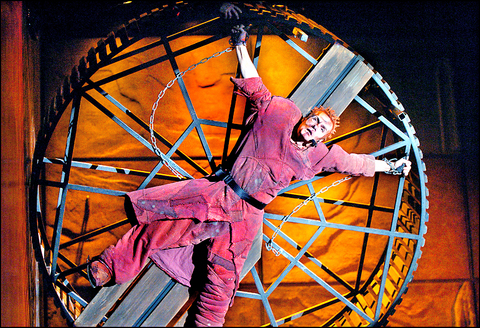Given the huge success of Victor Hugo's Les Miserables as a musical, it was only a matter of time before the French novelist's 1831 tale of love and betrayal, Notre Dame de Paris, hit the stage. Hollywood produced a film version in the 1930s, and Disney created an animation; but not until the mid-1990s did the tragedy become a major French language musical. Now on its first Asian tour the production will run for 10 days at the Sun Yat-sen Memorial Hall in Taipei.
French-Canadian Lu Plamondon made a name for himself as a lyricist writing songs for Celine Dion before he started composing rock operas in the seventies. After his box office hit Starmania in 1979, he combined his talent for writing lyrics with Italian composer Richard Cocciante's talent for writing music. The two worked on the Notre Dame project for three years before joining forces with dance theater director Gilles Maheu.
Notre Dame de Paris was first staged in France in 1998 and with a cast of European and Canadian musicians it achieved record-high ticket sales in its first year of production. Equally popular is the DVD and album version starring musicians Daniel Lavoie and Bruno Pelletier. An English translation of the show with guest appearance by Celine Dion was performed in the UK and the US but never reached the same level of success as its French predecessor.

PHOTO COURTESY OF NEW ASPECT
The cast has evolved since its first staging seven years ago but still boasts a number of established actors and musicians. French songstress Nadia Bel stars in the lead role as Esmeralda alongside Canadian vocalist Matt Laurest as Quasimodo.
More than 50 songs are included in the repertoire producing a show almost entirely told through song and dance with a few interpolations of dialogue. The choreography blends classical, street and acrobatic styles and complements the costume design, which also combines period pieces with modern-day themes. Set in 15th-century Paris the legendary Notre Dame cathedral is a fitting backdrop to the story.
Remaining true to Hugo's novel, Plamondon does not conceal its tragic outcome behind a happy ending. The show's narrator, Gringoire, sets the mood by opening with a song about changing values and emerging public unrest in the city. Exploring themes of love and prejudice, the story focuses on the ill-fated Esmeralda, a beautiful gypsy dancer from Spain and the deformed bell-ringer Quasimodo.
Phoebus, captain of the king's cavalry, is set to wed Fleur De Lys, but when his eyes fall upon the Spanish dancer his heart becomes torn between the captivating woman and his duty to Fleur De Lys and his country.
A callous priest Frollo and the naive hunchback Quasimodo are also in love with the young woman. The priest, unable to have her for himself, becomes consumed by jealousy. Accused of a crime she did not commit, Esmeralda is thrown in jail. Murder and betrayal ensue as the story reaches its climax and heartrending conclusion.

That US assistance was a model for Taiwan’s spectacular development success was early recognized by policymakers and analysts. In a report to the US Congress for the fiscal year 1962, former President John F. Kennedy noted Taiwan’s “rapid economic growth,” was “producing a substantial net gain in living.” Kennedy had a stake in Taiwan’s achievements and the US’ official development assistance (ODA) in general: In September 1961, his entreaty to make the 1960s a “decade of development,” and an accompanying proposal for dedicated legislation to this end, had been formalized by congressional passage of the Foreign Assistance Act. Two

March 31 to April 6 On May 13, 1950, National Taiwan University Hospital otolaryngologist Su You-peng (蘇友鵬) was summoned to the director’s office. He thought someone had complained about him practicing the violin at night, but when he entered the room, he knew something was terribly wrong. He saw several burly men who appeared to be government secret agents, and three other resident doctors: internist Hsu Chiang (許強), dermatologist Hu Pao-chen (胡寶珍) and ophthalmologist Hu Hsin-lin (胡鑫麟). They were handcuffed, herded onto two jeeps and taken to the Secrecy Bureau (保密局) for questioning. Su was still in his doctor’s robes at

Last week the Democratic Progressive Party (DPP) said that the budget cuts voted for by the China-aligned parties in the legislature, are intended to force the DPP to hike electricity rates. The public would then blame it for the rate hike. It’s fairly clear that the first part of that is correct. Slashing the budget of state-run Taiwan Power Co (Taipower, 台電) is a move intended to cause discontent with the DPP when electricity rates go up. Taipower’s debt, NT$422.9 billion (US$12.78 billion), is one of the numerous permanent crises created by the nation’s construction-industrial state and the developmentalist mentality it

Experts say that the devastating earthquake in Myanmar on Friday was likely the strongest to hit the country in decades, with disaster modeling suggesting thousands could be dead. Automatic assessments from the US Geological Survey (USGS) said the shallow 7.7-magnitude quake northwest of the central Myanmar city of Sagaing triggered a red alert for shaking-related fatalities and economic losses. “High casualties and extensive damage are probable and the disaster is likely widespread,” it said, locating the epicentre near the central Myanmar city of Mandalay, home to more than a million people. Myanmar’s ruling junta said on Saturday morning that the number killed had